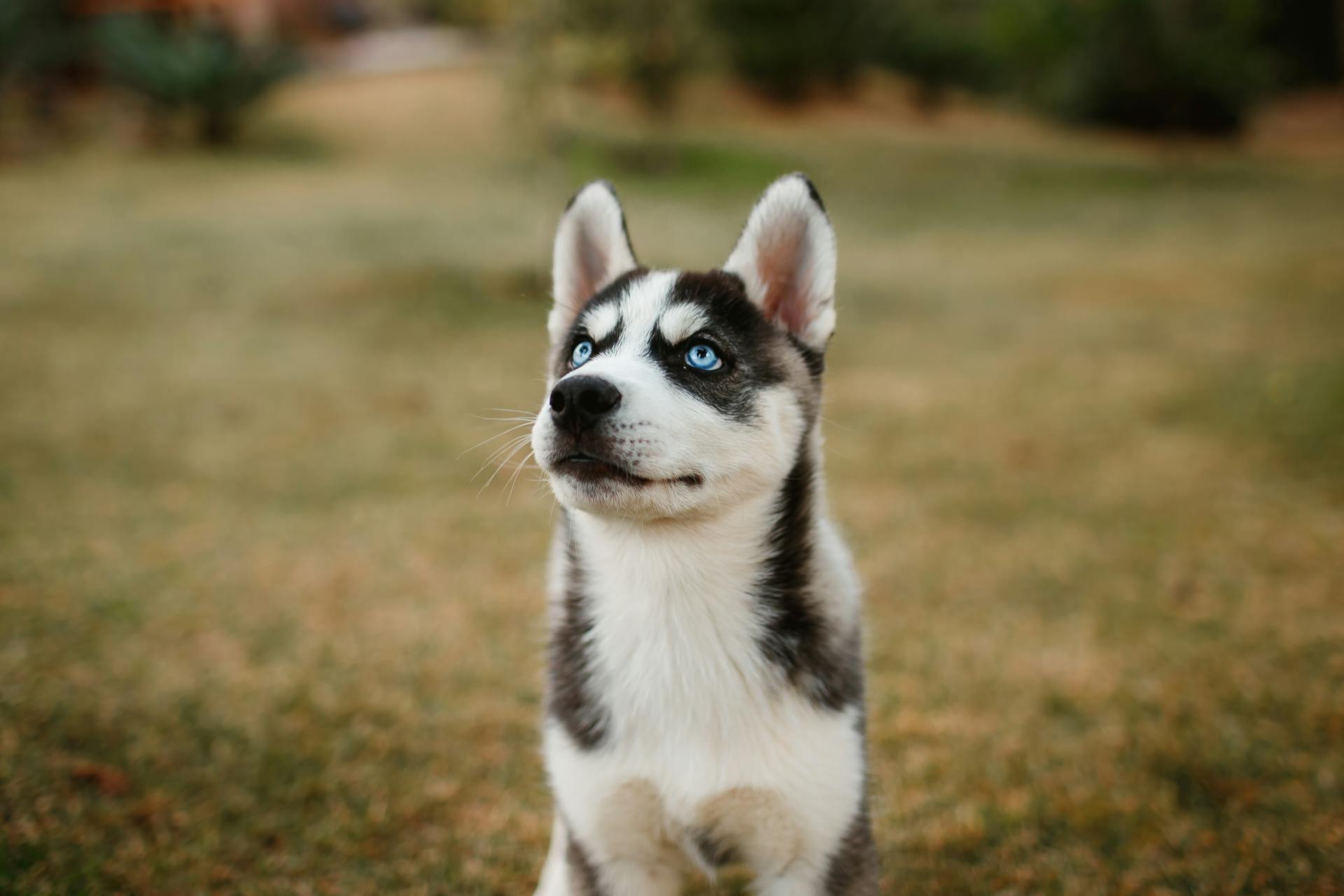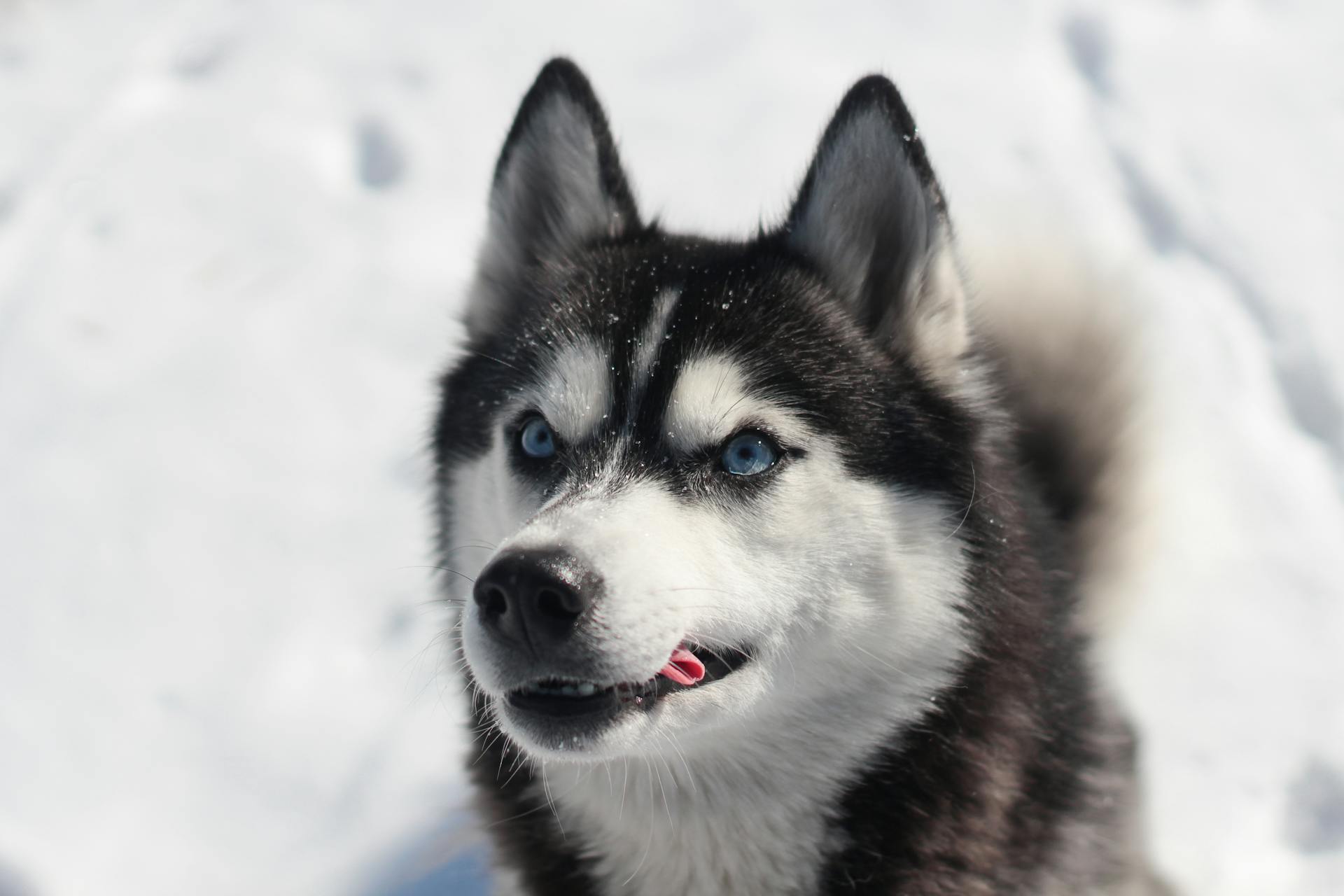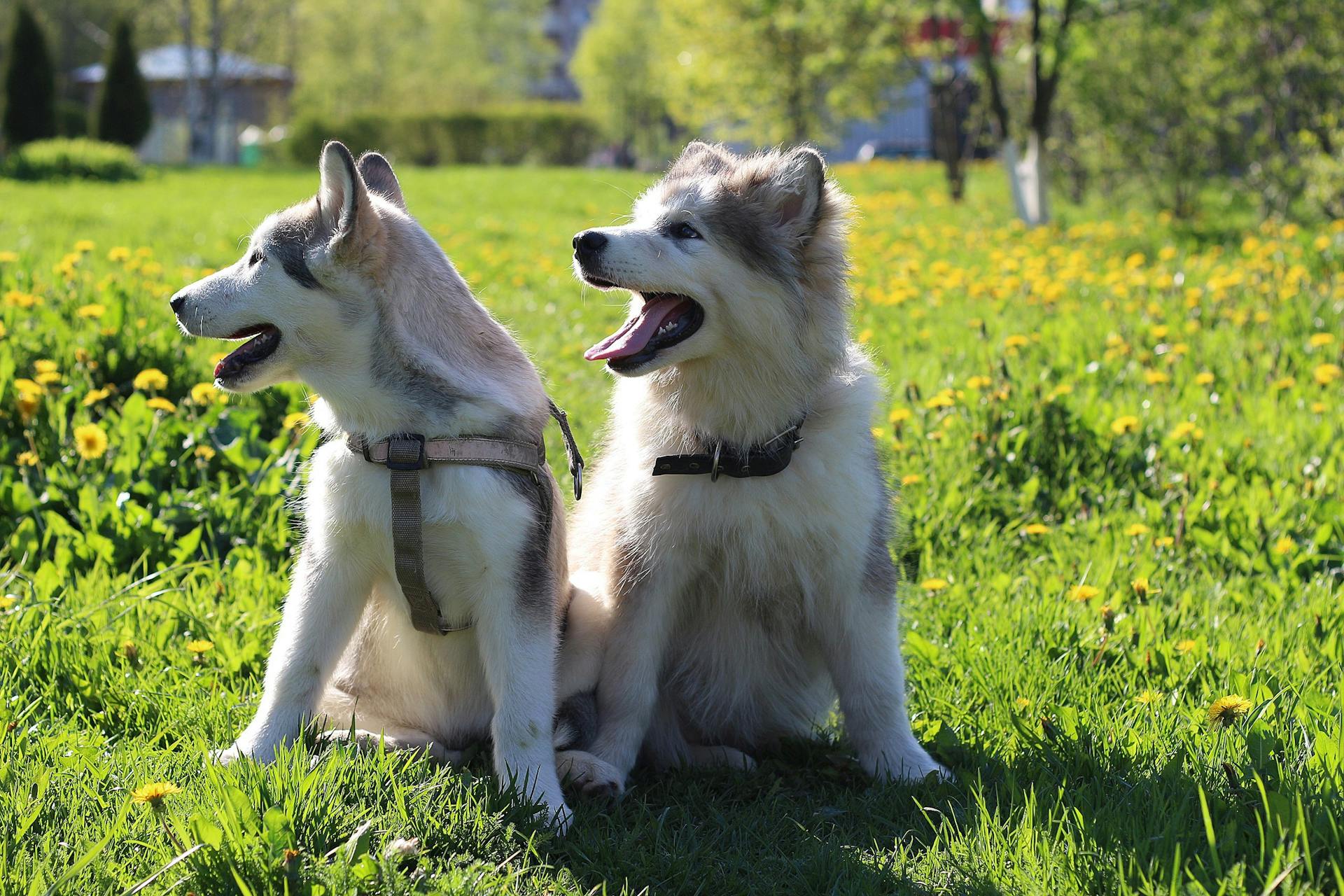
Red Huskys are a variation of the Siberian Husky breed, known for their striking red coat. They're a relatively rare color variation, but still a beloved companion for many dog owners.
The Red Husky's unique appearance is due to a genetic variation that affects the production of the pigment phaeomelanin, resulting in their distinctive red or cream-colored coat. This variation is not a result of cross-breeding with other breeds, but rather a natural occurrence within the Siberian Husky gene pool.
Red Huskies are generally just as friendly and outgoing as their more common gray and black counterparts, with a strong prey drive and high energy level. They require regular exercise and mental stimulation to prevent boredom and destructive behavior.
For your interest: How Big Do Siberian Huskies Get
Physical Characteristics
Red Huskies are a stunning breed, and their physical characteristics are just as impressive as their personality.
Their ears are erect, triangular, and sit up high on their head, giving them a distinctive look.
Their eyes are almond-shaped and can be blue or brown, with some Huskies even having one eye of each color. I've seen this unique trait in person, and it's truly striking.
Their nose is straight, well-defined, and neither pointed nor square, and it can be black, liver, or even pink depending on their coat color.
Their coat is a medium-length, double coat with long guard hairs on top and a soft, thick undercoat. This means they shed a lot, so be prepared for regular grooming sessions.
Their coat color is one of their most distinctive features, and it can range from solid colors like white, black, or gray to more complex patterns like sable or agouti. Red Huskies, of course, have a beautiful reddish hue to their coat.
Here are the different colors a Red Husky's nose can be:
- Black
- Liver (brown)
- Pink
Their tail is thick with fur and resembles a fox tail, curving upwards when they're at attention and trailing when they're at rest.
Temperament
Red Huskies have big personalities that are often mischievous and love running and escaping. They're outgoing and wicked smart, which makes them fantastic as work dogs.
They have a strong prey drive and may chase cats and small animals, so it's essential to socialize them early and properly. With patience and training, they can get along well with everyone.
Red Huskies are known to howl instead of barking, which draws the comparison to wolves. They also make weird talking noises, often sounding like Wookies.
A big fenced-in yard is recommended for Red Huskies, as they have a strong instinct to escape and explore. Secure fencing is a must to prevent exploratory escapades.
Red Huskies are strong-willed, which may make training a bit of a challenge. However, with consistent training and socialization, they can be a well-behaved family member.
Here are some key traits to consider when thinking about bringing a Red Husky into your family:
- Outgoing and mischievous
- Wicked smart and love testing boundaries
- Strong prey drive and may chase small animals
- Howl instead of bark
- Need secure fencing and a big yard
Care and Maintenance
Red huskies require regular grooming to prevent excessive shedding and keep their coat looking its best. You'll want to brush them with a pin brush three to five times a week to prevent a furry mess.
To minimize shedding, it's essential to brush your red husky's undercoat regularly, especially during high shedding seasons in fall and spring. This will help loosen fur and prevent it from swirling around your ankles.
A daily teeth brushing habit will also prevent periodontal disease. Take your red husky to the vet for a professional cleaning once a year.
Here's a quick rundown of the grooming schedule:
Remember, red huskies have a thick coat that helps regulate their body temperature, so avoid shaving or clipping their coat, as this can cause them to overheat.
How to Care for
Caring for a Siberian Husky requires some effort, but it's worth it to keep them happy and healthy. First and foremost, you'll need to brush their beautiful fur regularly, ideally twice a week, to prevent matting and tangling.
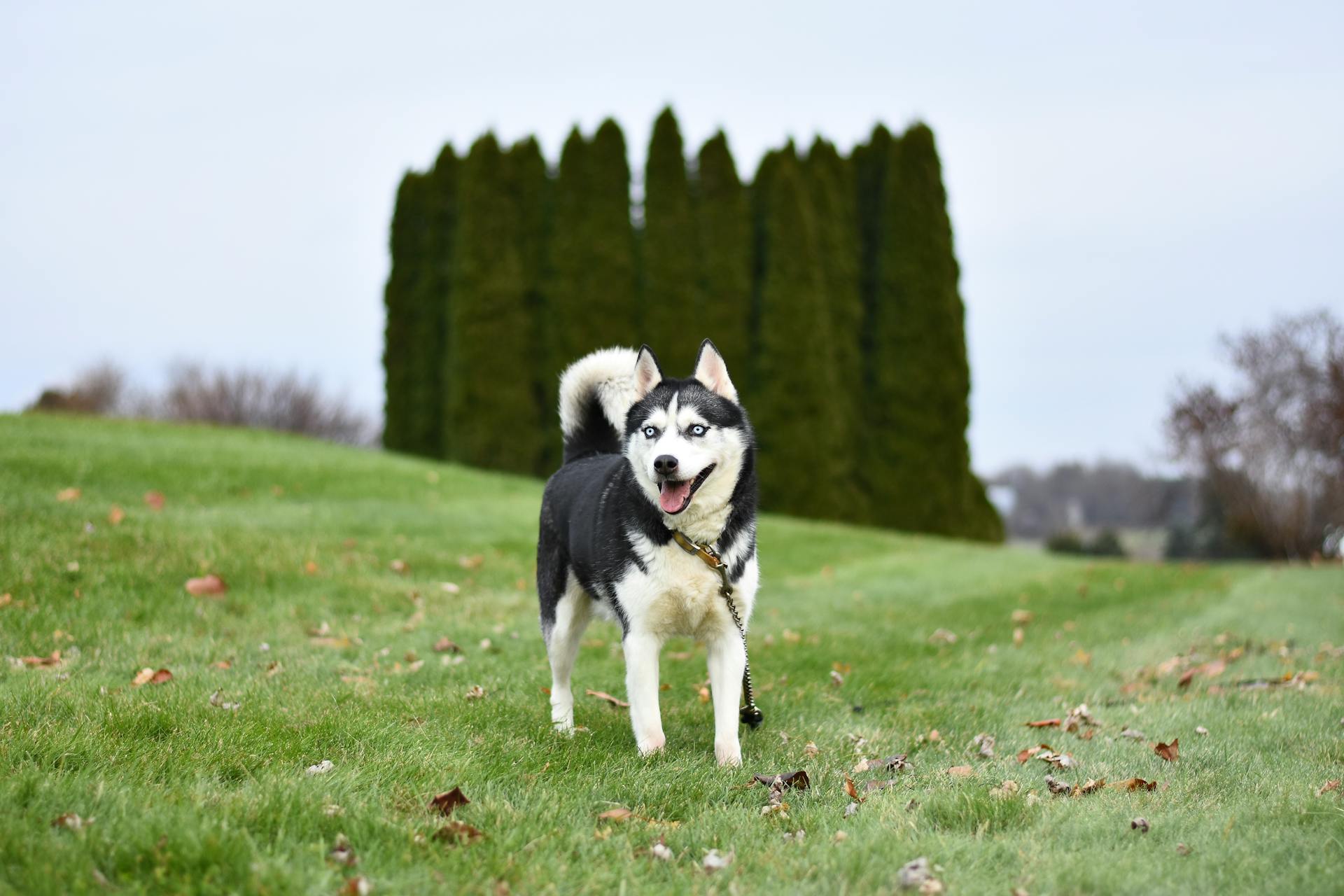
Brushing their hair not only keeps them looking great, but it also helps to loosen fur during high shedding seasons, which typically occur in the fall and spring. To make it easier, use an undercoat rake daily during these times.
Bathing your husky is also crucial, but only when they naturally smell or accumulate dirt. Use a medicated shampoo and avoid over-bathing, as this can strip their coat of its natural oils.
Regular grooming appointments are a must, especially during the summer months when the weather can get hot. These appointments will help to keep your husky's skin and coat in top condition.
In addition to grooming, serving your husky a veterinarian-approved diet is essential to provide them with all the necessary nutrients. A balanced diet will help to keep their skin and coat healthy, and prevent any potential health issues.
Here's a quick guide to help you keep track of your husky's grooming needs:
By following these simple tips and guidelines, you'll be well on your way to caring for your Siberian Husky and keeping them happy and healthy.
Stock Images
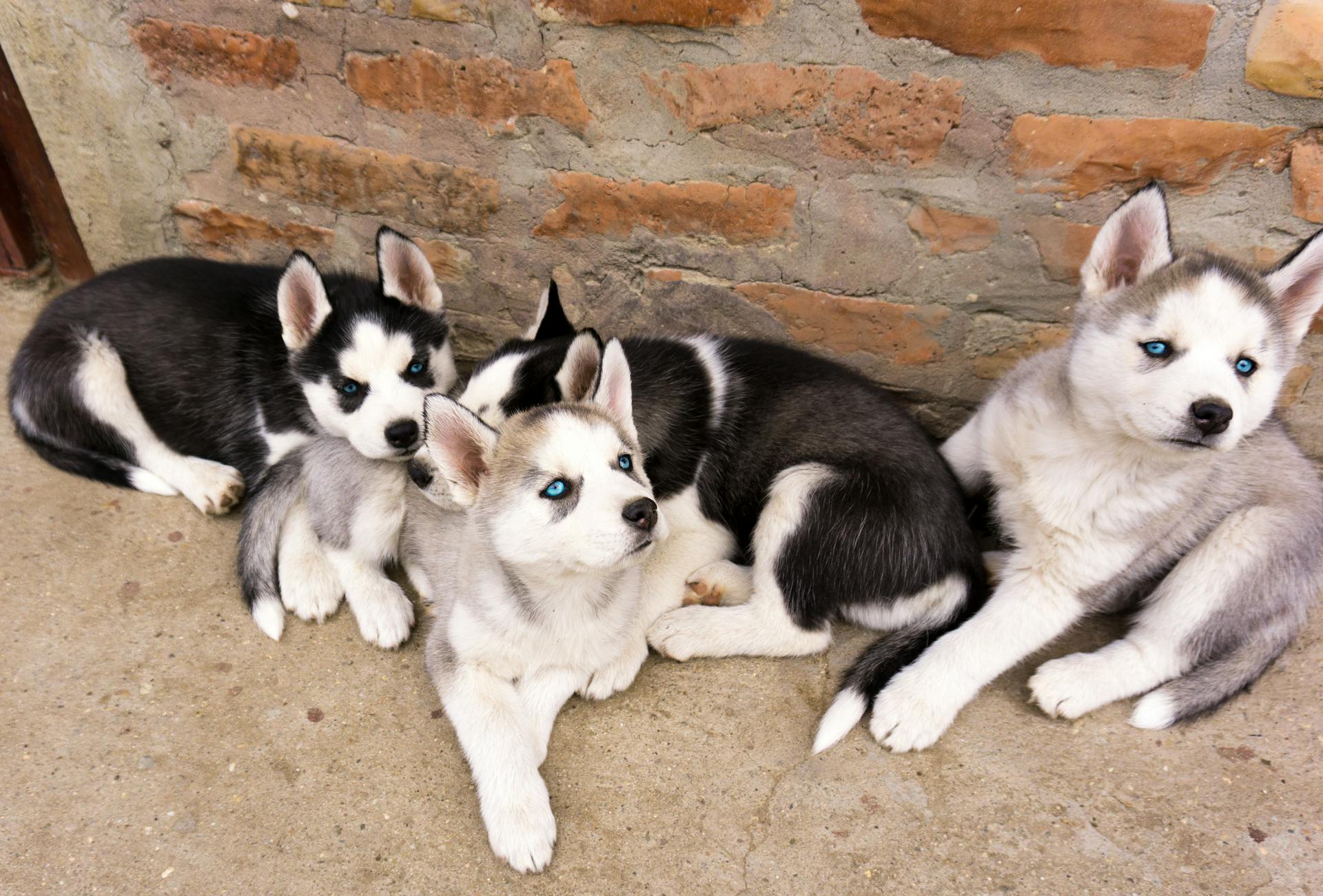
You can find over 1,400 red Siberian Husky stock photos and images available online.
Red Siberian Huskies have a unique appearance, making them a popular breed for photography. They can have a brown and white coat, with brown eyes and a distinctive facial structure.
Their beautiful coats require regular grooming to prevent matting and tangling. This can be a fun bonding experience for you and your Husky, and it's essential for their overall health and well-being.
Red Siberian Huskies are known for their energetic and playful personalities, making them a joy to photograph. They're often depicted in outdoor settings, such as forests and mountains, where they can run and play freely.
As they grow and mature, Siberian Huskies will shed their coats, which can be a bit messy but also a great opportunity for some fun and creative photography.
A unique perspective: Do Siberian Huskies like Cats
Health and Wellness
Red Huskys are generally a hearty and healthy breed, with a lifespan of 12-14 years. They can live up to 16 years, which is quite remarkable for a medium to large dog.
Siberian Huskies are prone to certain health issues, including ocular problems, which can affect their vision. These eye health issues can be genetic, so it's essential to have your Red Husky checked regularly by a vet.
Von Willebrand Disease is a bleeding disorder that can be present in Red Huskies, but it may not show up until they experience prolonged bleeding after an injury or surgery. A vet can screen your pup for this disorder, and dogs with it may need a blood transfusion with routine surgery.
Hip dysplasia is another potential issue, caused by a genetic deformity of the hip socket. Signs include limping, difficulty jumping, and pain, which can be managed with weight management, joint supplements, medication, or surgery.
Autoimmune skin disease, also known as pemphigus foliaceus, can affect Red Huskies, leading to hair loss and crusts on the skin. This condition can be treated with immunosuppressive medications, steroids, and antibiotics.
Epilepsy is a seizure disorder that can be inherited in Red Huskies, typically appearing between 6 months and 5 years old. If your Red Husky is prone to epilepsy, they may be prescribed medications to manage their seizures.
Here are some common health issues that can affect Red Huskies, along with their typical age of onset:
- Ocular issues: can occur at any age
- Von Willebrand Disease: may not show up until an injury or surgery
- Hip dysplasia: can appear at any age, but often shows up in younger dogs
- Autoimmune skin disease: typically begins at around 4 years old
- Epilepsy: tends to show up between 6 months and 5 years old
- Hypothyroidism: can appear at any age, but often shows up in older dogs
History
The Siberian Husky's rich history is fascinating. They originated in Northeast Asia around 4,000 years ago and were first bred by the Chukchi people for protection.
Their ancestors were likely influenced by the Taymyr Wolf that once roamed North Asia. The Siberian Husky shares a close lineage with the Alaskan Malamute.
The breed's significance extended beyond Siberia when folks seeking fortune brought them to Alaska to pull sleds during the Gold Rush era. They participated in sled-dog races alongside the Alaskan Malamute and Samoyed.
In 1908, Siberian Huskies made their way to Alaska where they became sled-racing dogs. This marked a new chapter in their history as sled dogs.
Siberian Huskies are intelligent, goofy, energetic, and stubborn, making them a popular family pet in America.
Explore further: Are Siberian Huskies Good with Kids
Eye Care
If you notice your Husky's eyes turning red, it's essential to get them checked out by a vet. This could be a sign of an underlying health issue, such as allergies, foreign bodies, or conjunctivitis (also known as pink eye).
Allergies, for example, can cause redness and irritation in your Husky's eyes. Scratching or skin conditions can also lead to red eyes, making it crucial to keep an eye on your dog's overall health.
Some common eye problems in Huskies include glaucoma, dry eye, and prolapse of the eye, also known as cherry eye. These conditions can be painful and even lead to vision loss if left untreated.
Worth a look: English Bulldog Eyes Red
When Eye Color Changes
As a dog owner, you might notice changes in your Husky's eye color during their puppyhood. This is a normal process that usually completes by the time they're 16 weeks old.
All dogs are born with blue eyes, and it's not uncommon to see variations in shades and hues as their eye color changes. This is because their eye color is determined by their genetic makeup.
You may notice a gradual change in your Husky's eye color as they grow into adulthood, and it's less likely to change unless something causes it.
Reasons for Husky Eye Contact
If you've ever looked into your Husky's eyes and seen that they're a deeper, more intense color, it's likely due to a condition called conjunctivitis, also known as pink eye.
This inflammation of the conjunctiva can cause the blood vessels to become more visible, making the eyes appear red. It's a common issue in dogs and can be caused by a variety of factors, including allergies and foreign bodies.
Allergies are a common culprit behind red Husky eyes, and can be caused by a range of triggers, from pollen to dust mites. If you suspect that your dog's allergies are causing their eye problems, it's essential to speak with a vet about the best course of treatment.
The good news is that many of these conditions can be treated with medication or lifestyle changes. For example, if your Husky has dry eye, your vet may recommend a special diet or eye drops to help keep their eyes moist.
Curious to learn more? Check out: Red Eyes in German Shepherds
Here are some common reasons for red Husky eyes:
- Conjunctivitis (inflammation of the conjunctiva)
- Glaucoma (increased pressure in the eye)
- Dry eye
- Prolapse of the eye, also known as cherry eye
In some cases, red eyes may be a sign of an underlying health issue, such as glaucoma or a prolapse of the eye. If you notice any unusual changes in your Husky's eyes, it's always best to err on the side of caution and consult with a vet.
You might like: Why Are My Fish's Eyes Red?
Frequently Asked Questions
How rare is a red Husky?
Red Huskies are a relatively rare breed, but their popularity is increasing. They are recognized by the AKC, making them a unique and sought-after companion.
What is a red Husky called?
A red Husky is a Siberian Husky with a red coat color, not a specific breed. They are recognized by the American Kennel Club as having an Agouti and white coat color.
What is the rarest color of Huskies?
The rarest color of Huskies is white, characterized by a complete lack of color markings besides white. This rare color often comes with striking blue eyes.
Featured Images: pexels.com
